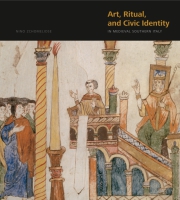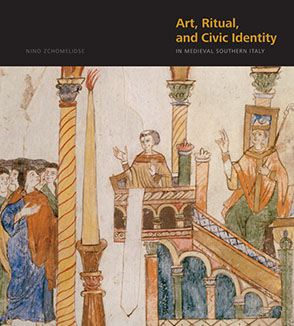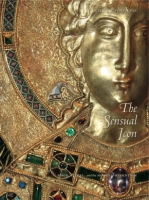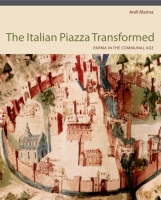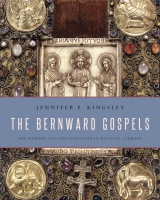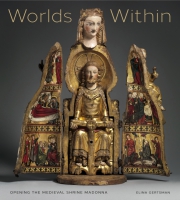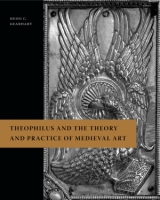Art, Ritual, and Civic Identity in Medieval Southern Italy
Nino Zchomelidse
“This remarkable book transforms our understanding of the meaning and function of the liturgical art of Italy: the pulpits and ambos, monumental sculpted candlesticks, pavements, and chancel screens that are among the greatest masterpieces of medieval sculpture. Nino Zchomelidse’s volume is the first coherent explanation of how these liturgical objects articulated the dynamic role of liturgical theater to further the goals of the Gregorian reform. Indeed, this ecclesiastical furniture reconfigured religious ritual in both horizontal and vertical space within the medieval church, enhancing vision, drama, and the visual experience of the laity. Created by some of the greatest sculptors of the twelfth and thirteenth centuries, these liturgical objects were initially commissioned by bishops and the upper clergy, who were often buried adjacent to them; by the mid-thirteenth century, however, they were appropriated by members of the patrician elite as affirmations of local pride and multigenerational family commemoration.
- Media
- Description
- Reviews
- Bio
- Table of Contents
- Sample Chapters
- Subjects
Winner, 2015 Howard R. Marraro prize, the American Catholic Historical Association
In Art, Ritual, and Civic Identity in Medieval Southern Italy, Nino Zchomelidse examines the complex and dynamic roles played by the monumental ambo, the Easter candlestick, and the liturgical scroll in southern Italy and Sicily from the second half of the tenth century, when the first such liturgical scrolls emerged, until the first decades of the fourteenth century, when the last monumental Easter candlestick was made. Through the use of these objects, the interior of the church was transformed into the place of the story of salvation, making the events of the Bible manifest. By linking rites and setting, liturgical furnishings could be used to stage a variety of biblical events, in accordance with specific feast days. Examining the interaction of liturgical performance and the ecclesiastical stage, this book explores the creation, function, and evolution of church furnishings and manuscripts.“This remarkable book transforms our understanding of the meaning and function of the liturgical art of Italy: the pulpits and ambos, monumental sculpted candlesticks, pavements, and chancel screens that are among the greatest masterpieces of medieval sculpture. Nino Zchomelidse’s volume is the first coherent explanation of how these liturgical objects articulated the dynamic role of liturgical theater to further the goals of the Gregorian reform. Indeed, this ecclesiastical furniture reconfigured religious ritual in both horizontal and vertical space within the medieval church, enhancing vision, drama, and the visual experience of the laity. Created by some of the greatest sculptors of the twelfth and thirteenth centuries, these liturgical objects were initially commissioned by bishops and the upper clergy, who were often buried adjacent to them; by the mid-thirteenth century, however, they were appropriated by members of the patrician elite as affirmations of local pride and multigenerational family commemoration.
Zchomelidse is the first scholar to fully utilize the visual and textual evidence of the Exultet rolls to explicate medieval ritual within church interiors prior to the Council of Trent. Her deeply learned and insightful interpretation is a milestone for scholarship on the dynamic roles of art, ritual, theatrical presentation, and patronage in central and south Italy.”“Art, Ritual, and Civic Identity in Medieval Southern Italy offers a rich analysis of the roles that pulpits, candlesticks, and other fixtures played in preaching and liturgical performance. Examining local and continuously changing practices, multiple uses of single monuments, music, burial customs, iconography, the relation of words to images, church reform, the meaning of unfolding, the significance of darkness (and light), and myriad other issues that enliven the appreciation of specific works, the book provides a subtle overall account of how design and decoration not only framed but also fashioned the real activities that took place in medieval churches.”“What were the conceptual relationships between liturgical manuscripts and church furnishings during the Middle Ages, and how were those relationships enacted and understood during liturgical performances? Nino Zchomelidse’s learned and highly interdisciplinary study of three centuries of medieval art in turbulent southern Italy provides complex and compelling answers to such critical questions. This well-researched and beautifully produced book is an essential contribution to the burgeoning field of southern Italian studies, as well as to art history and medieval studies in general.”“This book fully realizes medieval scenography. It vividly presents practices of liturgical performance in a rich range of light, spectacle, smell, and touch that unfolds in an entirely realized time and place. South Italy in the Late Middle Ages comes to compelling life in Zchomelidse’s hands, and the illustrations, so well chosen and finely produced, form an integral part of her strongly persuasive arguments. The cultural lives of the south Italian cities are faceted and evocative. Anyone interested in performances of identity ought to read this significant work.”“In this sumptuously illustrated and beautifully written volume, Nino Zchomelidse invites the reader to reimagine the southern Italian church as a space in which elaborately carved furnishings, illustrated scrolls, and decorated candlesticks guided ritual movement, captured the sound of voiced prayer, united communities in common worship, and proclaimed civic pride.”“From start to finish, in her fascinating analysis of ambos and candlesticks of Campania, Nino Zchomelidse keeps her eye firmly on the points cited in the title: Art, Ritual, and Civic Identity, summarising the complexity of the links between art and liturgy from several points of view and tracing out a line of development for liturgical furnishings within the religious and historical milieu in which they were made. The approach is interdisciplinary and opens the door to social, liturgical and musical history, including the latest trends in art-historical studies that look at the concepts of agency, performativity, and the anthropology of images. The results of this study are presented in a fascinating way even for a public that has little knowledge of these (sometimes arduous) subjects.”“This is a complex and erudite study based on the author’s close reading of the liturgical texts and close observation of the liturgical objects. It answers many questions about the arrangement of the pulpits and the unfurling of the Exultet rolls while focusing on the liturgy that inspired the works of art.”“Formidably learned, its dense arguments ranging widely over literature and theology as well as sculpture and painting, and discussing Byzantine, central, and northern Italian exemplars as well as those from southern Italy, the book is by no means easy reading. However, it thoroughly repays the effort it demands. In her introduction the author briefly reviews earlier publications on the material and artistic culture of southern Italy, commenting on their rising number and growing importance. The present volume is a distinguished addition to these studies.”“[Nino Zchomelidse] is to be thanked for producing a work which is both stimulating and provocative.”Nino Zchomelidse is Assistant Professor of Art History at Johns Hopkins University.
Contents
List of Illustrations
Acknowledgments
Abbreviations
Introduction
1 Staging the Logos: The Ambo in the Medieval Mediterranean
2 Unfurling the Logos: The Exultet Rolls of South Italy
3 Liturgical Change and the Double Stage
4 Trees of Light: Exegesis and Liturgy in the Context of the Easter Candlestick
5 Allegory and Remembrance: Lay Patronage in the Angevin Kingdom
6 The Saint and His City: Hagiography, Relics, and the Panels of Santa Restituta in Naples
Epilogue: Imitatio Christi and Civic Identity in Angevin Gaeta
Appendixes
Iconographic Indexes
Notes
Bibliography
Index
Introduction
Let us imagine for a moment a specific event in the liturgical life of the Christian community in a southern Italian town in the eleventh century. At the beginning of the Easter vigil, the most sacred ceremony of the church year, the clergy and faithful assemble in a darkened cathedral to witness a crucial moment of liturgical drama: the lighting of the Easter candle. Standing high on the ambo, the deacon touches the monumental candle with one hand. In the other, he holds an illustrated scroll inscribed with the text and music of the Exultet hymn. As he begins to sing the prayer of the blessing of the Easter candle, declaring loudly, “Rejoice now, angelic choir of the heavens,” the scroll, which literally embodies the Word of God, slowly unfurls over the ambo’s lectern. When the deacon intones, “[A]nd shining with the splendor of the eternal king, feel the darkness of the whole world dispelled. Let mother church, too, be glad, adorned with the brightness of such splendor; and let this hall resound with the great voices of the people” —the powerful chant fills the church. As if by magic, the candles held by the faithful, who have transferred the flame from the deacon’s candle to their own, are lit throughout the church. The vigil celebrating the Resurrection of Christ begins.
This dramatic moment of liturgical celebration is represented with exquisite detail in the Exultet roll no. 2 in the Museo dell’Opera del Duomo (Museo Diocesano) in Pisa, an illuminated parchment scroll made at Montecassino. The image, located at the top of the scroll and therefore next to the hand of the deacon holding it, introduces a number of objects that form the material core of this study: a monumental ambo, the Easter candlestick, and the liturgical scroll. Through their use, the interior of the church was transformed into the place of the story of salvation, making the events of the Bible manifest. Under this conceptual model, which linked rite and setting, the liturgical furnishings could assume different roles and could be used to stage a variety of biblical events, in accordance with specific feast days. Examining the interaction of liturgical performance and the ecclesiastical stage on which it unfolded, this book talks about the creation, function, and change of significance of church furnishings and manuscripts in southern Italy, including Sicily. It spans the time from the emergence of the first such liturgical scrolls in the second half of the tenth century until the first decades of the fourteenth century, when the last monumental Easter candlestick was made.
Unlike other parts of the Italian peninsula, Benevento, the region under consideration in this study, followed a rite that was introduced by the Lombard tribes, who came to the south in the sixth century. The creation of liturgical furnishings and manuscripts in this region was connected with the distinct traditions contained in the so-called Beneventan rite. The symbolic meaning of their decoration was revealed only when they were “set in motion” during the performance of the rite. A particularly good example of this phenomenon is the Rogadeo pulpit in Ravello, which shows two episodes from the story of Jonah and the Whale. As an image of Christ’s Resurrection, the story of Jonah was an important component in the readings of the Beneventan Easter liturgy, and the decoration of the pulpit was linked to the symbolic value of the episodes.
Issues of secular governance are as critical to the understanding of artistic phenomena in southern Italy as are liturgical developments. Rulership over the region changed over the centuries with the successive invasions of Normans, Hohenstaufen, and French Anjou. These invasions forged the creation of the Kingdom (regnum) of South Italy and Sicily, which was governed by the respective dynasties. This book maintains that the civic communities in the kingdom exploited the rituals themselves as well as the decoration on ecclesiastical furnishings to affirm their historical roots. In the south Italian cities, alliances were often formed between the citizens and the local church against the foreign rulers in Palermo and Naples. In this context, liturgy and art were consciously chosen as vehicles of political ideology and civic identity. While the political aspect of medieval sculpture in the context of the independent communes in central Italy has, in particular, long been recognized, few attempts have been made to investigate the issue in the context of the cities in the south. A recent book by Brendan Cassidy (2007), a comprehensive study of Italian sculpture, politics, and civic ideas, deserves special credit for including the programs of Frederick II’s bridge gate at Capua and the Angevin tombs in Naples. Yet, while Cassidy observes reflections of civic identity in the programs of the Pisani pulpits in Tuscany, he does not engage with the political dimensions of the liturgical furnishings made in the cities of southern Italy.
Only during the Anjou reign was the Beneventan liturgy finally replaced by the Roman rite. The new lay elite of the kingdom, with its ties to the court in Naples, emerged as ambitious patrons of the local churches. Wealthy family clans challenged the traditional design of church furnishings with innovative motifs that were driven by the desire for representation and memoria (remembrance) of the donors, as seen in the Rufolo pulpit in Ravello. Other innovations concern the creation of extensive narrative cycles of early Christian martyred bishops that translate the events of the civic communities of the distant past into the time under discussion, such as the Santa Restituta panels in Naples and the Gaeta candlestick. With the collapse of the Angevin rule in the late Middle Ages, when the Beneventan rite and its meaning seem to have faded from memory, the production of monumental ambos, candlesticks, and liturgical scrolls in the region came to an end.
Despite the general acceptance of the importance of this fascinating multicultural area of the medieval Mediterranean, no recent comprehensive analysis of the material and artistic culture of southern Italy exists, aside from the early groundbreaking studies by Heinrich Wilhelm Schulz and Ferdinand von Quast (1860), Demetrio Salazaro (1871–77), and Émile Bertaux (1903 [1904]). These scholars were fascinated by the beauty, high quality, and specific eclectic style of art in the region and provided the first encyclopedic introductions of the main monuments of southern Italy. Since then, art-historical studies have focused on a specific and limited region, time period, or artistic medium, or they have been determined thematically. In 1991, Dorothy Glass undertook a pioneering study of medieval sculpture of the modern Italian region of Campania, starting with its eleventh-century origins in Montecassino and ending around 1220. Following this trend, Francesco Gandolfo has worked on Campanian sculpture in the Norman and Hohenstaufen periods, with a particular focus on workshop practices. More recently Valentino Pace (2007) has provided an encyclopedia of the art and architecture in medieval Campania. The Amalfi shore and nearby city of Salerno have attracted scholarly attention as well, in particular by Jill Caskey (2004), who has investigated the art and architecture in Amalfi and its hinterland from the viewpoint of merchant patronage, raising important questions of cultural history. Antonio Braca (1994 and 2003) has focused on medieval art in Salerno, primarily considering artistic attribution, chronology, and iconography. William Tronzo (2003–4 and 2011) has provided a fascinating picture of the eclectic artistic patronage of the Norman king Roger II in Palermo, in particular the royal chapel in his residence, the Cappella Palatina. In recent years, Caroline Bruzelius, Lorenz Enderlein, Tanja Michalsky, Serena Romano, Nicolas Bock, and Paola Vitolo have concentrated their research on medieval Naples, specifically on issues of representation and memory—for instance, in relation to tombs (Enderlein, Michalsky), the history of the cathedral (Romano and Bock), and Angevin patronage (Bruzelius, Vitolo).
Since the 1936 publication of the systematic catalogue of the southern Italian Exultet rolls by Myrtilla Avery, which contained reproductions of all scrolls but no analytical text volume, the Exultet rolls have been studied for their imagery—for example, in the exhibition catalogue of 1994 or in monographs dedicated to one scroll or to groups of scrolls, such as those by Guglielmo Cavallo and Anna Rosa Calderoni Masetti. Because of its broad intellectual scope, combining the analysis of the liturgy with that of the music, the fundamental book by the musicologist Thomas F. Kelly (1996) on the Exultet in southern Italy has been particularly inspiring for this study.
The growing importance of medieval southern Italy is reflected in the rising number of historical studies on the region’s history and people, in particular by Armand Citarella on the economic history of Amalfi, Giovanni Vitolo on civic identity in Naples and Salerno in the High Middle Ages, Andreas Kiesewetter on the Angevin kingdom under Charles II, and Paolo Peduto and François Widemann on Ravello and the Rufolo family especially. Studies on the civic communities and the church in the Norman Kingdom of South Italy—for example, by Patricia Skinner, G. A. Loud, and Paul Oldfield—have contributed significantly to the better understanding of the complexities of the multifaceted history and culture of the region.
This book is inspired by and indebted to all these studies—their specific focus, methodologies, and the knowledge they have added about medieval south Italy. My own interest is conceptually bound to the interaction between liturgical furnishings, their decoration and illuminated manuscripts, and the rituals during which they were activated. Rather than a simple congruence between liturgy and works of art, I am more interested in the different modes of interaction that occur between church furnishings, images, and ritual movement. The benefit of such an approach to medieval art and architecture has been demonstrated for Byzantium by the studies of Thomas Mathews and Sharon Gerstel. Following this same path, I contribute to the recent methodological discourses in art history, most importantly with regard to the performative aspects of works of art and their reception. This approach also builds on considerations that are connected with the concept of agency and an understanding of ritual as a performative act, in particular anthropological perspectives—for example, Victor Turner’s analysis of rites of passage and Alfred Gell’s evaluation of the interactive relationship between art and the viewer as a process. With this combination of new methodological thinking, detailed visual analysis, and rigorous historical investigation, I hope to provide a critical and comprehensive history of a particularly significant aspect of the material culture of medieval south Italy.
The book is structured around six chapters and an epilogue that center on the different aspects of the Easter rite, as described above. Chapter 1, dedicated to the ambo, traces the origins of this crucial item of church furniture in the medieval Mediterranean, as well as its ritual use and allegorization in early medieval and Byzantine theology. The Lombard clergy had developed a distinct liturgy in which the ambo formally and conceptually continued to be the stage for the pronunciation of the divine Word and the drama of the story of salvation. I argue that the Jonah imagery of the Rogadeo ambo in Ravello underscored the allegorical dimension of the pulpit, particularly in regard to the feast of Easter (see fig. 1). In this moment, it became a powerful visual component in the Exultet liturgy that reenacted the events of the Passion and Resurrection of Christ.
Chapter 2 concentrates on the Exultet rolls and investigates the performative qualities, or “mediality,” of these liturgical scrolls. I reconstruct the development of the new medium of the illustrated vertical roll, designed for a public ritual viewing, and explore the ways in which its imagery enhances the symbolic meaning of the liturgical act. The miniatures, I maintain, relate to the various forms of movement activated in the Easter liturgy. During the performance of the Exultet hymn, the unfurling of the scroll over the pulpit’s edge evoked the divine Word descending and becoming flesh. In most instances, the scroll would unfurl from a lectern decorated with the eagle of John the Evangelist, making this connection even more explicit. The meaning of the scroll as the descending divine Logos would be complemented by the allegorization of the ambo as the tomb of Christ, indicated by the images of Jonah and the Whale.
Chapter 3 revisits the ambo and investigates the shift away from the Jonah type to a setting of two symmetrically arranged pulpits, a process contemporary with the gradual conquest of southern Italy by the Normans in the course of the eleventh and twelfth centuries. The new arrangement reflects the alliances made between the Norman rulers and papal Rome. The popes forcefully promoted the Roman liturgy, in particular the Divine Office, as the sole liturgical practice everywhere in Italy. In Rome the reform resulted in the conception of a nave enclosure, typically made of marble, including two or even three pulpits designed for the singing of chants and responsories of the new liturgy and the reading of the Holy Scripture. I argue that under the influence of Rome, the two monumental pulpits in the cathedral of Salerno were conceived from the beginning as a double stage. They were used by the members of the cathedral choir (schola cantorum) for the performance of the Divine Office, the Liturgy of the Word, and the Easter celebrations. This claim is supported with an analysis of two unpublished liturgical manuscripts from the Salerno cathedral archive (included in appendixes 2 and 3), which document the liturgical practices at the time of their making. Particularly revealing is the reconstruction of the Palm Sunday festivities, because they took place in the city itself. The liturgy traditionally performed inside the church was transferred to the outside, using the entire urban area of the city. The new rite transformed the liturgy into a re-creation of the biblical story and turned Salerno into Holy Jerusalem, merging the ideas of city (civitas) and church (ecclesia).
Chapter 4 shows that the idea of multiple signification, as demonstrated for the medieval ambo and Exultet rolls, also applies to the monumental Easter candlestick. The candlestick’s inherent symbolic value within the story of the Resurrection inspired the creation of specific imagery that showed the complex relationships between the liturgical and biblical meanings of the candelabrum itself. In the abbey of Montecassino, a now-lost example (made ca. 1070) of precious shining metal visualized the Easter message through the symbolic power of its material at the moment the candle on it was being lit. The candlestick in the cathedral in Capua (ca. 1200) incorporated an explicit exegetical layer in its program by typologically pairing a liturgical scene with the respective biblical narrative. Based on my analysis of a contemporary source, the liturgical representation on the candlestick reflects the traditional Beneventan liturgy. The liturgical image therefore turns the candlestick in Capua into a retrospective monument that refers to venerable regional traditions. This documentary dimension characterizes the monument as a later creation conceived after the implementation of the liturgical reform—which, from a local viewpoint, constituted the “crisis” of the liturgical tradition of southern Italy.
The remaining chapters and epilogue investigate the new conceptual principles that determined the making of liturgical furnishings at the peak and during the aftermath of this liturgical change. A new and more centralized form of government was introduced into the region, in tandem with a sophisticated court life in the new capital of Naples. Liturgical furnishings became more and more connected to the rising status of the population and the wealth of the civic communities in the kingdom. Chapter 5 examines the visual function of allegory, portraiture, and heraldry in the decoration of pulpits in the context of the Hohenstaufen and the Angevin dynasties in the thirteenth and fourteenth centuries. The Rufolo pulpit in the cathedral of Ravello, for example, was donated by wealthy citizens with close ties to the court in Naples and conceived as a multifunctional item of church furniture, serving also as a family mausoleum and as a church (chapel). An innovative iconography characterizes the pulpit: profile images of the donors engage with a magnificent bust of a crowned female. I argue that the bust subtly merges the Christian personification of ecclesia and the ancient goddess Tyche into the allegory of the Ecclesia Ravellensis. The sculptural decoration of the pulpit draws heavily on the classical heritage of the past, which had become fashionable in the context of the new rulers. My book suggests that the Rufolo ambo also connects with the contemporary development of the complex allegorical programs that emerge in the context of the independent communes in Tuscany—for example, in Pisa and Siena.
Chapter 6 and the epilogue are dedicated to the grand narrative cycles on liturgical furnishings that were created for the ambo in the cathedral of Naples (1240–60) and the Easter candlestick in Gaeta (ca. 1430s). Both programs feature prominent historical figures, early Christian bishop saints and martyrs whose relics were venerated in these cities, Ianuarius in Naples and Erasmus in Gaeta. They became the chosen city patrons and were instrumentalized by different forces (religious and secular) in the civic communities. The program of the Santa Restituta panels, which I argue were part of the pulpit in the Ianuarius cathedral of Naples, explicitly uses aspects of the local cult to hypostatize the figure of the bishop. The story of the bishop saint is integrated into a web of several other cycles and offers—in addition to the creation of complex narrative structures—an abundance of typological reference systems.
In contrast to the Neapolitan pulpit, the Gaeta Easter candlestick offers a narrative of the Erasmus vita that is structured as a spiral and paired with a vita Christi. The two cycles are determined by tendencies to create condensed continuous narratives, combined with an interest in highly detailed narrative precision, a development that can be seen in the arts at the time in general. The Christological and hagiographic narratives form a generic ecclesiological program that is applied to the form of the Easter column. The candlestick, once a piece of church furnishing that was heavily charged with ritual traditions, now was determined by a specific form of civic identity connected with the local church. This interplay created a type of public sphere with close interactions between communal and liturgical rites.
Monumental ambos, Easter candlesticks, and illuminated Exultet rolls in medieval southern Italy were created to be “set in motion” during the performance of the Easter liturgy. By investigating these works of art in connection with the evocative power of the rituals in which they were used, this book addresses the conceptual nature of medieval art also on a more general level. May the reader find the interdisciplinary approach that situates this study at the crossroads of medieval art history, social and religious history, and medieval liturgy and music to be a valuable piece in the complex puzzle that defines medieval art in southern Italy and beyond.
Also of Interest
Mailing List
Subscribe to our mailing list and be notified about new titles, journals and catalogs.
